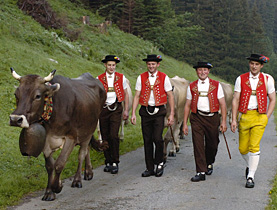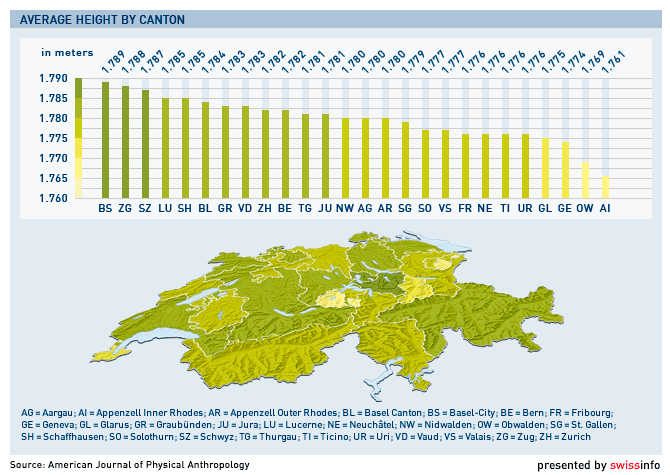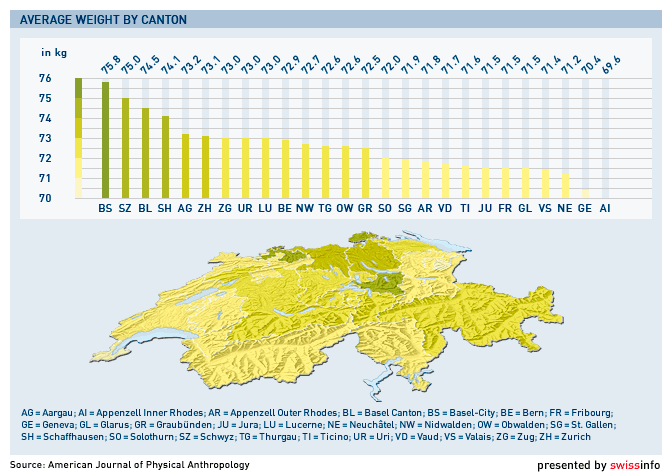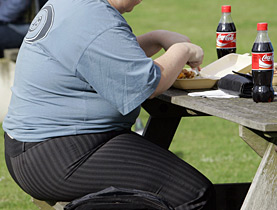The long and short of Swiss cantons

Men in the eastern Swiss canton of Appenzell Inner Rhodes may not be too thrilled to learn that they have been named the shortest in the country.
At 1.761m, they are 2.8cm shorter than men in Basel, the country’s tallest, according to research published by Zurich University’s Institute of Anatomy.
The findings are the result of a study into whether people’s height and weight are affected by where they live, their professional and linguistic backgrounds and even the month they were born.
Using the 2005 census of the armed forces, researchers plotted data from more than 28,000 male conscripts and found that all of the factors had some effect on height and weight.
“We were expecting these results but are still surprised to see them to this extent, knowing that Switzerland has a reputation for being an egalitarian society and having one of the highest social-economic statuses,” Frank Rühli, of the research team, told swissinfo.
“There are differences between different cantons. The people from Appenzell Inner Rhodes are statistically significantly smaller than the ones from Bern, for example.”
The cantons with the tallest average conscripts were located in German-speaking areas in central and northern Switzerland, while the Italian-speaking canton of Ticino showed one of the lowest average statures.
The study has also revealed that the average Swiss man has grown by ten centimetres in the past century. Average height of conscripts rose from about 1.69m in 1916 to 1.78m in 2005. Today their average height is comparable with that of white men in the United States and South Africa.
“There are studies saying that if you are taller you are more successful in life and you have more income,” said Rühli.
“But it’s difficult to say which is the egg and which is the chicken. Whether because you are taller you earn more or whether it is the opposite. It’s hard to tell. For males especially it is still a fact that it is better to be tall than short in stature.”
Preventative measures
The study showed that average height and weight differed by time of birth, with those born in the second half of the year significantly smaller and with a lower body mass index.
Those working in the industrial sector were shorter and heavier than fellow conscripts who were students.
Rühli said the findings were unique because the data was taken from conscripts in Switzerland’s militia army, providing a snapshot of a large cross-section – 80 per cent – of the male population from all cantons.
Switzerland was also a good case study because it provided an insight into a politically stable society that was geographically diverse, with added differences posed by the four native languages. Its 26 cantons were a mix of different mother tongues, histories, economics and levels of urbanisation.
Of greater concern than the height differences though, Rühli said, were disparities in weight among the cantons, with the highest average body mass indices in central and northwestern parts of Switzerland. The southern mountainous and western cantons were below average.
Once again Appenzell Inner Rhodes and Basel City men were at polar ends on the scales, weighing 69.6 and 75.8kg respectively.
The Institute of Anatomy team argue that varying weights between cantons could represent a “side effect of ‘luxury’ and may be linked with culturally affected nutritional habits”. They hope the findings will help the authorities adapt public health programmes towards those most in need.
“It is important to know which groups in society are at risk of having a high body mass, which is bad for your health,” added Rühli.
“That is something which people dealing with preventative measures in health should actually look at and see in which cantons people are more at risk.”
swissinfo, Jessica Dacey
Research for the study on Variability of Height, Weight and Body Mass Index in a Swiss Armed Forces 2005 Census was carried out by the Institute of Anatomy at Zurich University, in cooperation with the Anatomical Sciences centre at the University of Adelaide and the Institute for Empirical Research in Economics at Zurich University.
It was based on data from 28,152 male conscripts of the 2005 Swiss armed forces and represented 80% of all 19-year-old male Swiss citizens alive in that year.
The researchers analysed height, weight and the body mass index. They used the conscripts’ professions outside the army as an indicator of socio-economic status and their mother tongue as a cultural reference.
The findings have been published in the American Journal of Physical Anthropology.



In compliance with the JTI standards
More: SWI swissinfo.ch certified by the Journalism Trust Initiative












You can find an overview of ongoing debates with our journalists here . Please join us!
If you want to start a conversation about a topic raised in this article or want to report factual errors, email us at english@swissinfo.ch.